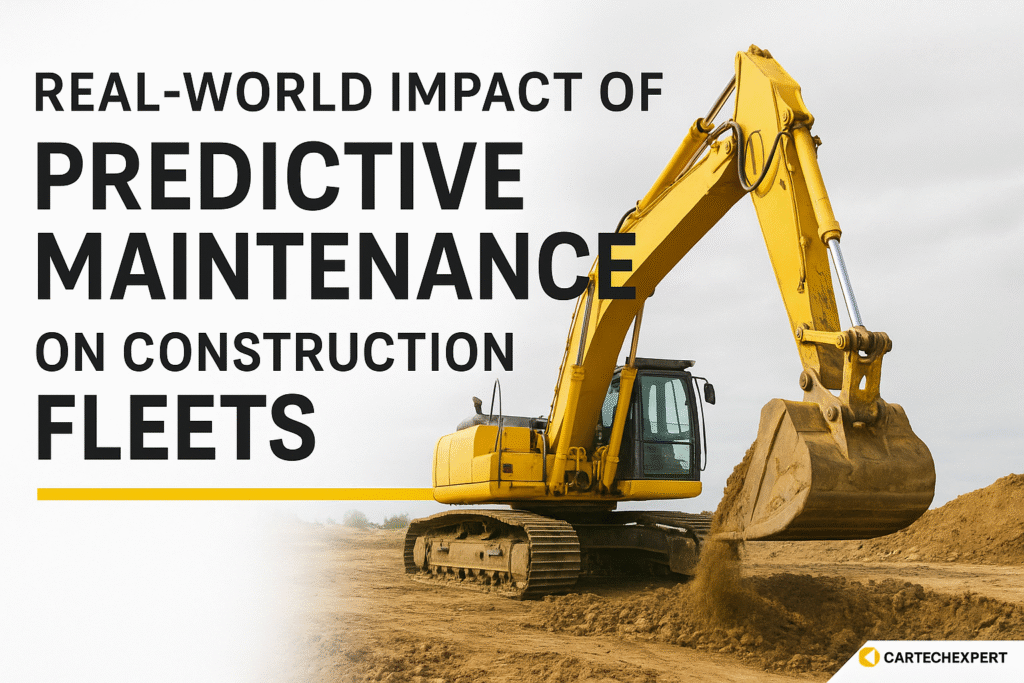Physical Address
Arthur Avenue , BrookField , ILLINOIS , 60513 , United State

You run a fleet of machines that move earth, lift loads, and keep projects on schedule. Every hour a machine is down is an hour of lost productivity, frustrated crews, and shrinking margins. Predictive maintenance changes that dynamic: instead of reacting to failures, you predict them — and act on insight.
This article explains how predictive maintenance really works for construction fleets, what technologies make it possible, and — most importantly — how you can implement it so your operation sees measurable results. By the end, you’ll have a clear, practical playbook you can use on your own yard.
Predictive maintenance (PdM) uses data — from sensors, telematics, and historical repair records — combined with algorithms and analytics to forecast when a component will fail or when performance will degrade below acceptable limits.
Construction equipment operates in harsh environments, faces variable loads, and often works far from service centers. Predictive maintenance catches patterns that indicate impending failure — giving you time to plan repairs, order parts, and schedule technicians so you avoid emergency breakdowns.
When implemented properly, PdM delivers measurable gains across operations. Typical benefits include:
Predictive maintenance is an ecosystem of hardware, connectivity, and software. These are the components you’ll rely on:
Temperature probes, vibration sensors, pressure transducers, flow meters, and oil-quality sensors collect raw signals from components such as engines, hydraulics, and transmissions.
Telematics units aggregate sensor data, GPS, and machine state information, then transmit it via cellular, satellite, or local gateways to a cloud platform.
Edge computing may preprocess data on the machine to reduce bandwidth. Cloud analytics run machine-learning models on aggregated datasets to detect anomalies and predict remaining useful life (RUL).
Algorithms learn from thousands of operating hours and failure cases to build models that identify precursors to failure with increasing accuracy.
Data must connect to your maintenance management system (CMMS), parts inventory, and scheduling tools so alerts translate into action automatically or with minimal human intervention.
Predictive maintenance only delivers if the organization adapts. Below is a practical workflow you can implement:
These condensed case studies show how predictive maintenance translates into money saved and uptime gained.
Problem: A hydraulic pump began developing minute pressure fluctuations that were not obvious in daily checks. PdM action: Vibration and pressure analytics flagged a trending anomaly with a high confidence interval predicting failure in ~150 operating hours. Outcome: The pump was scheduled for replacement during a planned downtime window, preventing a catastrophic failure on a critical job and saving the company $12,000 in emergency repairs and lost productivity.
Predictive soot-load analytics in DPF systems identified an injector causing rich combustion. Early correction prevented a DPF regeneration failure and avoided DPF cleaning costs and extended engine downtime that would have exceeded 48 hours. ROI realized within a single quarter.
Track these metrics to determine PdM effectiveness:
Set a baseline for 3 months before PdM rollout, then measure improvements at 3, 6, and 12 months.
Follow this practical sequence to ensure a smooth rollout and fast wins.
Be proactive about these typical issues:
Solution: Start with the top 3 failure modes that cost the most and implement narrow, high-confidence models. Expand after you show value.
Solution: Connect PdM alerts to CMMS work orders and ensure technicians receive clear, actionable steps in the work ticket.
Solution: Train operators and technicians on how to interpret and act on PdM alerts; celebrate early wins to build buy-in.
Solution: Prefer open-data platforms and vendors that provide exportable data formats and APIs to avoid vendor lock-in.
When selecting PdM tools and vendors, evaluate them using the checklist below:
Examples of useful tool categories:
This table shows common diagnostic signals, how PdM interprets them, and the recommended action you should take.
| Signal | What PdM infers | Recommended action | Priority |
|---|---|---|---|
| Rising vibration on hydraulic pump | Early cavitation or bearing wear | Schedule pump inspection; monitor flow/pressure | High |
| Coolant temp spikes under load | Restricted coolant flow or radiator fouling | Inspect cooling system; clean radiator; check fan clutch | Medium-High |
| Oil oxidation & increased particle count | Increased wear or contamination | Perform oil analysis, change oil/filter, inspect wear surfaces | Medium |
| Intermittent CAN bus errors | Wiring issues or grounding faults | Perform wiggle test, inspect connectors and ground straps | High |
| DPF differential pressure increase | DPF loading or injector issue | Attempt controlled regen; check injectors/fuel system if persistent | Medium |
A: Many operations see measurable improvements within 3–6 months from a focused pilot (reduced emergency repairs, better parts planning, and fewer lost hours).
A: Yes. While newer machines have richer data streams, you can retrofit sensors and use edge devices to capture the signals needed for effective models.
A: Accuracy depends on data quality and model maturity. Start with high-confidence predictions and improve models as you collect labeled failure data.
A: No — PdM augments technicians. It gives you better insight, clearer work orders, and the ability to prepare parts and tools in advance, making your technicians more effective.
A: Run a 10-machine pilot focusing on the top 1–2 failure modes that cost you the most money. Validate model accuracy and process integration before scaling.
Predictive maintenance is not a magic bullet — it’s a practical approach that brings real, measurable savings when implemented with focus and discipline. Start small, validate fast, and scale the program that proves value.
If you want practical templates, vendor checklists, and sensor recommendations to kickstart your PdM pilot, visit CARTECHEXPERT. Need tools and telematics hardware? Check our store at store.cartechexpert.com for recommended sensors, adapters, and analytics subscriptions.
CARTECHEXPERT — Experts in heavy equipment diagnostics, telematics, and maintenance strategy. We help fleets implement data-driven maintenance programs that cut downtime and improve profitability.
